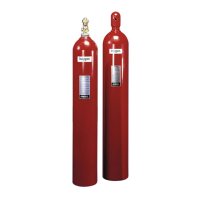ANNUAL MAINTENANCE EXAMINATION
General
Systems shall be maintained at regular intervals, not more
than one year apart, or when specifically indicated by an
inspection. (Exception: Cylinder pressure must be
checked every six months per NFPA 2001.) Maintenance
is a “thorough check” of the system. It is intended to give
maximum assurance that a system will operate effectively
and safely. It includes a thorough examination and any nec-
essary repair, recharge, or replacement. It will reveal if there
is a need for hydrostatic testing of the cylinder. The proce-
dures listed in this section are the minimum that is neces-
sary to maintain a system. If circumstances warrant them, a
more thorough procedure should be followed to assure sys-
tem performance. Make certain that all people affected by
the maintenance are informed before you start. This may
include the owner, security personnel, the local Fire
Department, and possibly local workers that may be affect-
ed by equipment shutdown or start up.
NOTICE
If the system includes an ANSUL
AUTOMAN II-C releasing device, before
proceeding with annual maintenance
examination, insert lock pin in ANSUL
AUTOMAN II-C release and remove nitro-
gen cartridge. Install safety shipping cap
on cartridge.
1. Survey the hazard to make certain it has not changed
from what the system was designed to protect. While
surveying the hazard, look for different fuels, loss of
hazard integrity, new hazards, etc.
2. Check all nozzles to make certain they are in place, that
the orifice plates are in place and with the proper orifice.
Check the condition of the nozzle for corrosion or dam-
age and make certain it is not obstructed internally or
externally.
3. Check the condition of the piping to make certain that it
is properly secured in the hangers and that all fittings
are connected tightly.
4. Check all warning nameplates throughout the area.
Make certain they are in place, mounted securely, read-
able, and are not damaged.
5. Check all cylinder bracketing. Make certain all cylinders
are secured in the brackets. Check for corrosion, dam-
age, or missing components.
6. Check the condition of all cylinders. Look for signs of
damage or corrosion, and check the cylinders last
hydrotest date. (NFPA 2001 states “Cylinders continu-
ously in service without discharging shall be given a
complete external visual inspection every five years or
more frequently if required. The visual inspection shall
be in accordance with Compressed Gas Association
Pamphlet C-6, Section 3; except that the cylinders need
not be emptied or stamped while under pressure.”)
Using the Pressure Test Gauge Assembly (Part No.
427953 for CV-98 valves), check each cylinder to deter-
mine if pressure is within the acceptable range. See
Pressure Correction Chart in the Appendix Section.
To use the pressure test gauge assembly, first make
certain cylinder is properly bracketed. Before attaching
assembly, make certain stem is completely backed out
by turning hand wheel counterclockwise until it stops.
Attach the assembly to the fill inlet port of the
INERGEN cylinder valve. Wrench tighten. To read the
cylinder pressure, turn handwheel completely clockwise
until it stops, then back it off 1/4 turn. This will open the
fill port. After pressure has been read, close fill port by
turning handwheel completely counterclockwise. Slowly
loosen the adaptor nut to remove the pressure test
gauge assembly from the fill port. While removing this,
you may hear a small hiss of pressure remaining in the
assembly. This is normal and will not last long. You will
also notice the gauge pressure will drop to zero.
Record the cylinder pressure for reference on the next
pressure test.
Visually note the location of the indicator needle on the
cylinder valve to determine if it is in close proximity to
the actual reading of the test gauge.
7. Check condition of all cylinder discharge hoses. Look
for signs of structural problems like abrasions or weath-
er checking. Make certain all hoses are connected prop-
erly. All hoses must be tested every 5 years. Refer to
NFPA 2001 for detailed testing requirements.
SECTION X
UL EX-4510 12-1-01 Page 10-1
Maintenance
ANSUL
®

